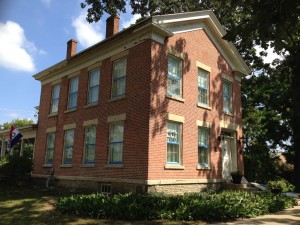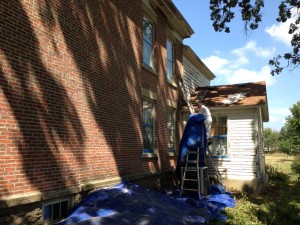This week, as paint restoration specialists from the Chicago area, we undertook work on a historical, 1858, Greek Revival and Federalist brick house built for Gustavus Palmer, a successful farmer and early settler in McHenry county. The house sits on its original corner lot in Crystal Lake, Illinois and still looks quite impressive. In 1985, the house was added to the National Register of Historical Places and the Park District is now responsible for the preservation of this special piece of McHenry county history.
Because of its design, the house has no gutters. The water drains over the large crown and dental moldings, and causes the paint to fail in a major way, thereby compromising the integrity of the original wood components of the building. As shown in the first picture, on the West side of the house, once the scraping process started, one hundred fifty five years of paint came off a twenty foot section of the crown. To preserve the wood, we used a product designed to restore wooden boats. The product is a Clear Penetrating Epoxy Sealer (CPES) known as “ The Rot Doctor ”. It seals the wood fibers and creates an ideal surface for paint to adhere to.
As shown in the second picture, the problem was more severe on the East side of the house. The water had rusted through the original nails holding the dentals to the base molding. The base molding had warped and pulled away from the upper crown. In addition to the CPES product, we used epoxy to fill the gaps and cracks in the wood. As a final step before caulking and painting, we applied a coat of high-built adhesive primer to all the trim elements of the building, including the window casings, which were original to the house. The crown moldings and window casings were seemingly made of old-growth wood, which survived in these hash conditions, without rotting for over one hundred fifty years. This wood is still hard as stone today! Wood like this deserves every bit of care we can muster to help preserve it for another century or more.
As you can also see in the second picture, since our painting and decorating company is EPA Lead-Safe Certified, the paint scraping process was done in compliance with EPA regulations. It involved setting up containment for the paint debris, sealing the windows, wearing protective garments, respirators etc., all this in 90 degree heat this week!
As a pioneer and early settler’s house, the Colonel Palmer house is quite remarkable by its size, style and quality of materials used in its construction. This was no shack on the prairie! It is well worth preserving for the generations to come.









 Follow
Follow
